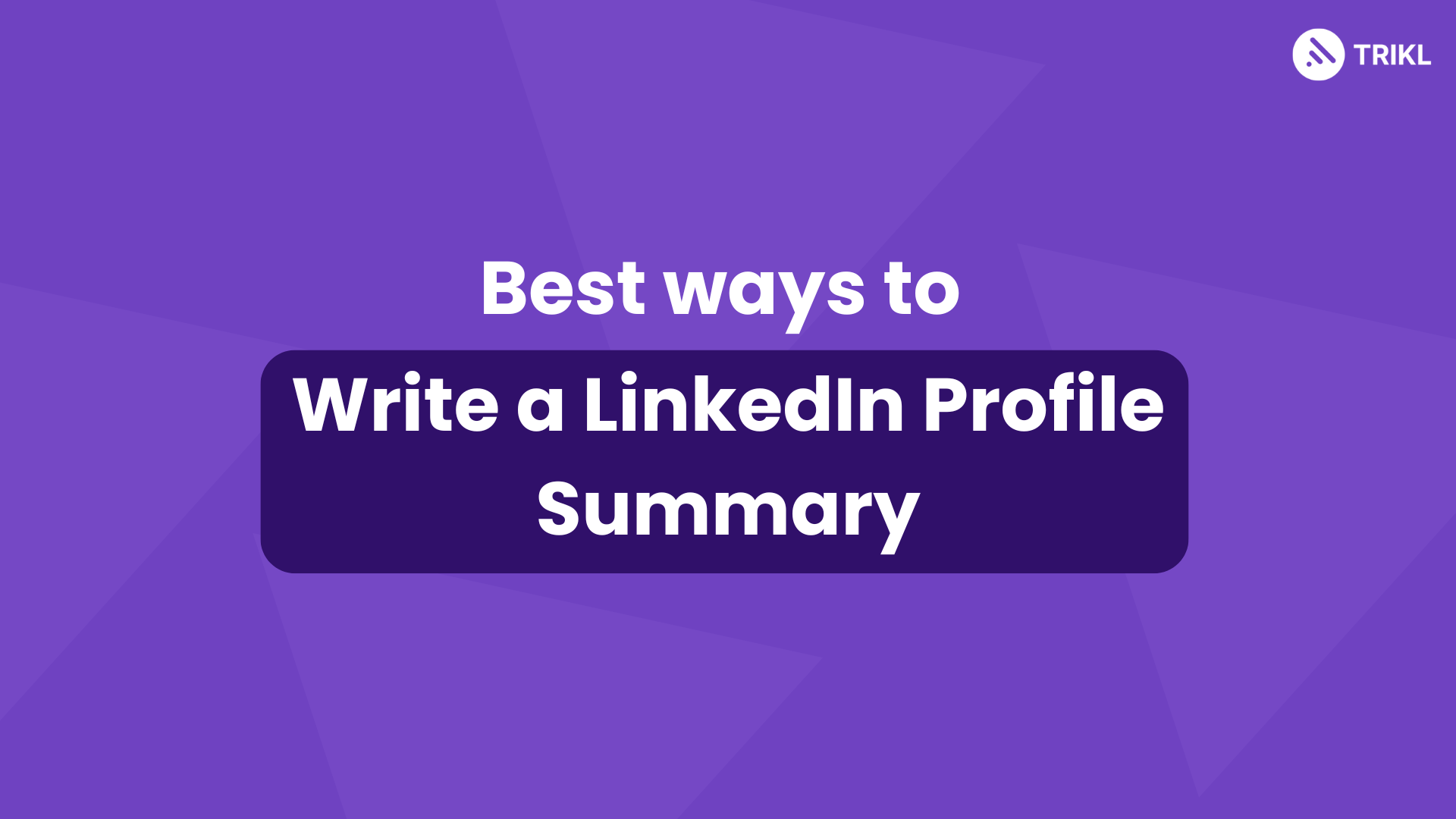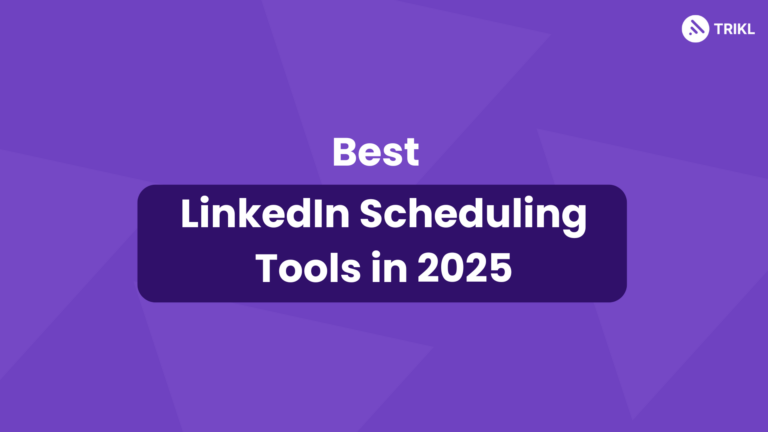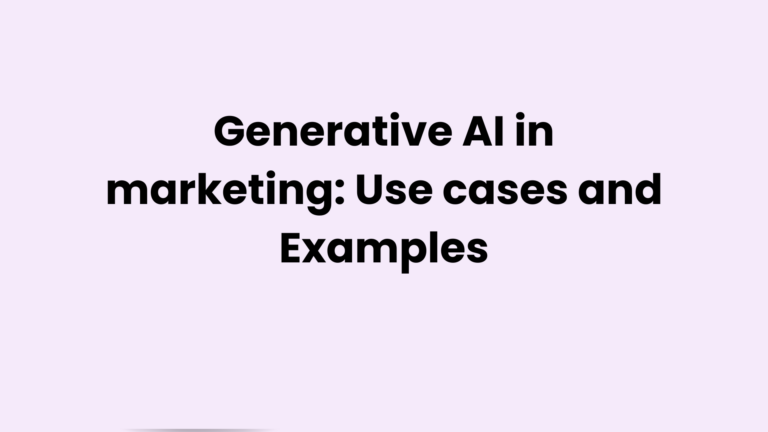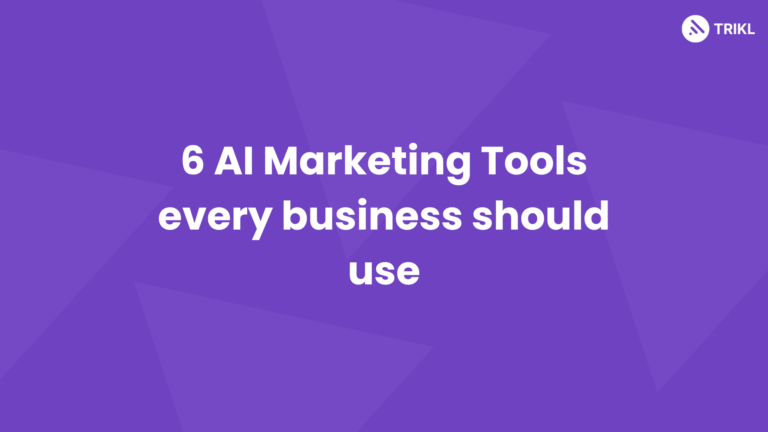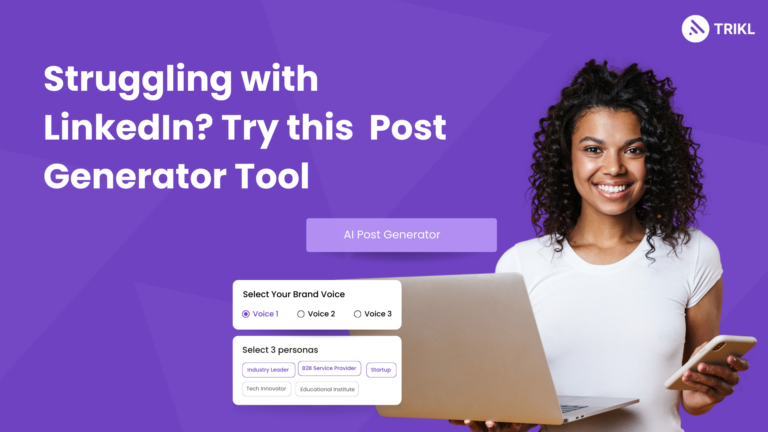You finally got time to update your LinkedIn profile. Or it’s your first time setting up your LinkedIn profile. And you come across the dreaded summary section of your LinkedIn profile. Also known as the about section.
In this blog post, we’ll help you write your perfect LinkedIn summary.
What is a LinkedIn profile summary?
A LinkedIn profile summary or the About section is a brief description of your professional journey. It includes information like your education, your career journey, skills and also your hobbies.
A LinkedIn summary is the most important element of your profile because it gives your recruiters an overall perspective of you as an individual. Summaries have a 2000 characters (roughly 400 to 500 words) limit but that’s enough to highlight your skills.
Here’s how a typical LinkedIn summary looks like-

But, before we talk about the steps to write your summary, let’s see why a LinkedIn summary is so important.
Why is a LinkedIn summary important ?
#1 Creates First Impression
A well-written summary creates a positive impression for recruiters. You might think that no one reads summaries. But this is the place where HRs will get a taste of your personality.
If your profile headline catches attention, then the summary gives out more information telling the reader whether they should proceed further with you or not.
#2 Improves searchability
Including relevant keywords related to your skills in your summary improves the searchability of your profile. Meaning, when recruiters are searching for a person similar to your skill set in the search box, your profile has a better chance of showing up in the search results.
For example, if your desired position requires good presentation skills, then mention it in your LinkedIn summary. You can make a list of required skills by analysing the job descriptions of your desired job.
#3 Work as conversation starters
Mentioning your other interests or hobbies briefly can be great because it’ll create a common ground for people interested in your profile to talk about.
For example, you like to travel and you’ve mentioned your favourite place to travel in your summary. A possible recruiter checking out your profile might have a similar interest. This can get the conversation started in a natural way.
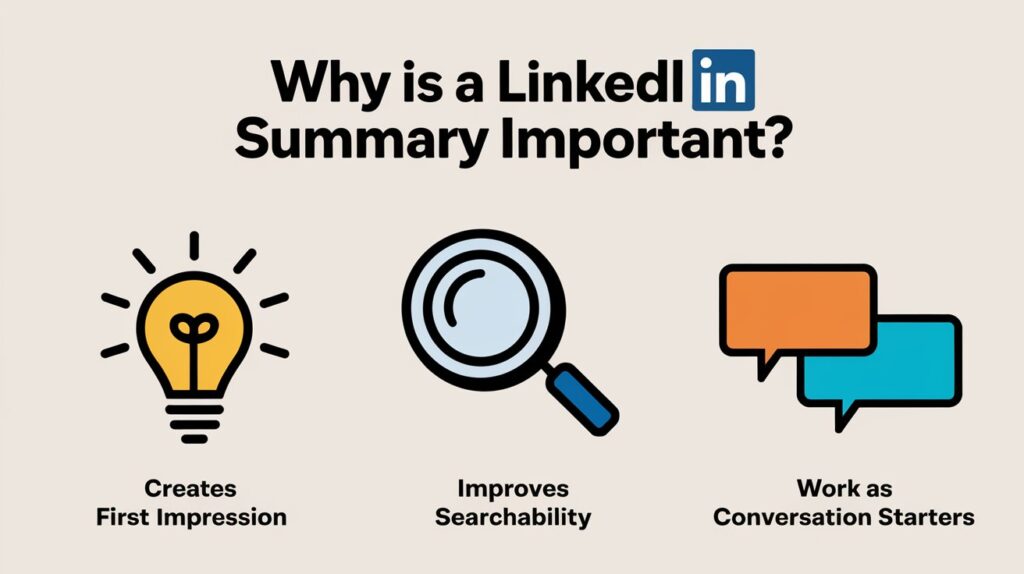
How to write an impressive LinkedIn profile summary
#1 Start with a strong hook
The entire about section is usually not visible when you check out someone’s LinkedIn profile. Only the first two lines are visible. To view the rest, you need to click on “more”. This is where writing a strong hook is important.
Here are some examples of great hooks.
“Over the last decade, I helped close 5000 sales successfully worth $1 million dollars.”
Or if you’re a fresher, you can start with how you discovered your interest. For example,
“I helped my friend set up his online business during college days and that’s when I discovered my passion for digital marketing.”
Feel free to experiment as much as you like!
#2 Highlight current role and expertise
Next, put maximum focus on your current role. Describe what you do, your responsibilities. If you’re an intern, mention what you do as an intern.
Or if you’re currently unemployed, talk about your last role or past projects that you worked on. Even if you’re switching from freelancing to a full-time role, talk about your best freelance projects.
#3 Outline your professional journey
Mention in brief about your education, your internships and your past jobs. You can do this step before you even start writing your summary. Create an outline of your professional journey.
However, don’t skip out on jobs which might be irrelevant to your current designation. You can always mention the relevant transferable skills you have.
For example, you used to provide private tuition to school kids while studying in college. Transferable skills you can mention are good communication skills and ability to manage time effectively along with your studies.
#4 Use numbers to highlight achievements
The best way to showcase your achievements is to list it out in bullets. And use numbers wherever possible. Doing this makes it easier for recruiters to scan and read.
For example, you’re a social media manager and you can list out your achievements like this,
“ * Increased followers from 0 to 10k in 6 months
* Build an online community of 20k people
* Helped bring 20 new inbound leads each month”
#5 Mention relevant skills
Always mention both your hard and soft skills. Here’s where most people tend to ignore their soft skills. Even for technical jobs, soft skills are as important as your core skills.
Some of the soft skills are great communication skills, being responsible and finishing the work on your own, time management and organization skills.
#6 Use storytelling
The best way to capture your reader is by storytelling. Instead of simply mentioning your journey in order, add a bit of story. Mostly it’s about adding tiny details that makes your writing unique.
For example, you are a data analyst now but from a young age you wanted to work in a library. This little piece of information might be irrelevant to the kind of job you’re looking for but it is highly relatable for most people.
Using story elements actually adds more personality to your LinkedIn summary and your recruiters will develop a strong perspective of your character.
7# Include CTA
The best way to end your LinkedIn summary is to include a CTA or call to action. Basically, it’s the next steps the reader can take to know more about you or your work further.
Some examples of good CTA are –
“To learn more about my work view my portfolio (link)”
“Want to talk? Let’s connect or send me an email at abc@gmail,com!”
Before adding a CTA, you can also include your future goals and aspirations.
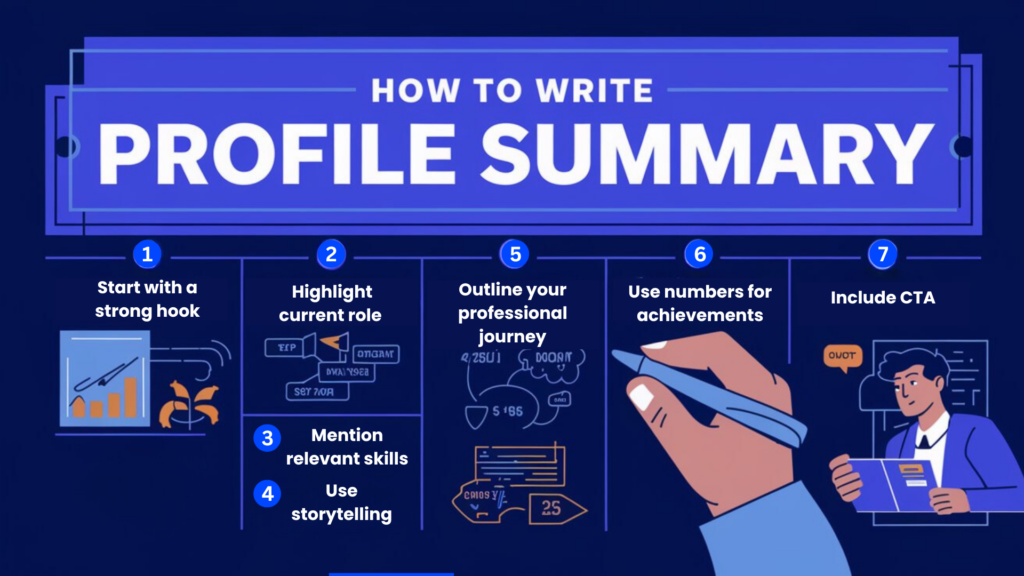
What not to do in a LinkedIn summary
#1 Don’t use jargons
No matter how serious your job role sounds, avoid using too much jargon in your LinkedIn summary. It can be off putting for many hiring managers. Stick to simple language while describing your professional experience.
#2 Don’t write in long paragraphs
A big chunk of text is not easy to read. So, always break up your summary into short paragraphs so it’s skimmable. Include more white space.
#3 Avoid using slangs
Avoid using terms like “cool”, “lit” or “vibe” in your LinkedIn summary. However, keep in mind the type of your job. Sometimes creative roles are okay with casual languages.
#4 No grammatical errors or spelling mistakes
Always proofread your LinkedIn summary before posting. It’s the worst thing to have a misspelled word in your summary and creates a bad impression. Even if it’s a typo, mistakes show that you didn’t care to proofread thoroughly before posting.
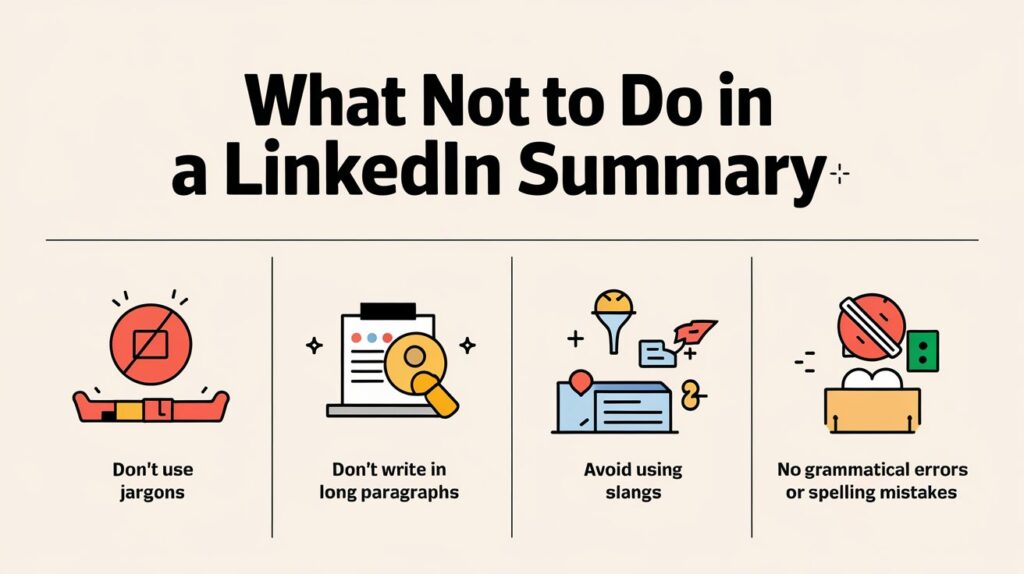
How to use ChatGPT to write a powerful LinkedIn summary
If you don’t want to DIY your LinkedIn summary, using ChatGPT to help you write one is a better option. Even if you have written your summary, you can always ask ChatGPT to polish it up for you.
Here are some prompts for ChatGPT that you can use to write your LinkedIn summary.
Prompt #1: Storytelling Format
“Craft a LinkedIn summary that tells a compelling story about my career journey, starting from [your starting point] to [your current role]. Emphasize how my experiences in [specific experiences] have shaped my unique expertise in [your niche]. End with an engaging call to action for connecting.”
Fill in the portions in “[ ]” according to you to get the best results.
Prompt #2: Professional
“Write a LinkedIn summary for a [your profession/role] that is creative, engaging, and reflects my personality. Focus on my passion for [your passion], my unique approach to [your work], and the impact I’ve made through [specific projects or roles].”
Prompt #3: Thought leader
“Write a LinkedIn summary that highlights my strengths in [your profession/industry] while positioning me as a thought leader. Include my skills in [list key skills], my achievements like [list achievements], and my career goal of [state your goal]. Keep the tone professional yet approachable.
Here’s a list of my skills – [mention all of your skills here]
Here’s a list of my achievements – [mention]”
3 LinkedIn summary templates
If you don’t want to go the ChatGPT way, you can use these templates to write your impressive LinkedIn summary! Just edit the details and it’s good to go.
#1 Professional
Best for: Executives and those in traditional industries
I’m a [professional title/role] with [X years] of experience in [specific industries or areas of expertise]. My work focuses on [specific tasks or skills, e.g., driving revenue through strategic marketing campaigns, solving complex technical challenges, or managing cross-functional teams].
What I’m best at:
- Expertise in [list 2-3 key skills or areas of expertise].
- Proven track record of achieving [specific achievements or goals, e.g., exceeding sales targets, improving efficiency by X%, or launching successful products].
- Passionate about [key interests related to your field].
I believe in [state your professional philosophy, e.g., leveraging data-driven insights to make impactful decisions or building strong relationships to drive collaboration and growth].
I’m always open to connecting with [professionals in specific roles, industries, or interests]. Feel free to reach out if you’re interested in [collaborations, networking, etc.].
#2 Storytelling format
Best for: Creative professionals and marketers
I never thought [specific event or realization] would change my career path, but it did. [Briefly describe the event or moment—e.g., helping a local business grow its online presence during college or discovering a knack for design while creating posters for a friend’s event].
Since then, I’ve been on a journey to [key goal or mission—e.g., create meaningful brand experiences, solve complex problems with creativity, or help businesses grow through innovative strategies]. Along the way, I’ve had the privilege to:
- [Highlight a key achievement—e.g., launch a successful product that reached X users].
- [Highlight another milestone—e.g., lead a team that doubled client engagement rates].
But it hasn’t always been smooth sailing. [Share a challenge or lesson learned—e.g., navigating a competitive market taught me the value of adaptability and constant learning]. These experiences shaped my approach to [specific focus or professional philosophy—e.g., designing with empathy, building data-driven strategies, or fostering collaboration].
Today, as a [your current role] at [current company], I focus on [your main responsibilities or contributions]. What drives me most is [your passion or motivation, e.g., seeing ideas come to life or making an impact through storytelling].
When I’m not working, you’ll find me [personal interest or hobby, e.g., sketching ideas for fun, exploring new cuisines, or mentoring aspiring professionals].
If you’re interested in [specific areas like collaborating on a project, sharing ideas, or discussing opportunities], I’d love to connect and chat!
#3 Skills and expertise-focused format
Best for: Tech professionals and consultants
With [X years] of experience in [your field/industry], I specialize in [specific area of expertise, e.g., software development, digital marketing, data analysis]. My work revolves around solving complex challenges and delivering measurable results for [type of clients, industries, or organizations you’ve worked with].
Key Skills and Expertise:
- [Skill 1 (e.g., Full-stack development using JavaScript, Python, and React)]
- [Skill 2 (e.g., Data visualization with Tableau and Power BI)]
- [Skill 3 (e.g., Search Engine Optimization and Paid Ad Campaigns)]
Notable Achievements:
- [Highlight a specific project, e.g., Developed an e-commerce platform that boosted sales by 40% within 6 months].
- [Highlight another achievement, e.g., Certified in [relevant certification] with expertise in [specific tool or technology]].
- [Highlight another measurable impact, e.g., Reduced operational costs by 20% through process automation].
Tools and Technologies:
- [List key tools or platforms you’re proficient in, e.g., AWS, Google Analytics, Jira, Figma, etc.]
Let’s connect to explore opportunities, collaborate on projects, or discuss ideas!
7 examples of LinkedIn profile summary for different professions
Here are 7 examples of real LinkedIn profile summaries which we liked and you can take inspiration from for writing your own summaries!
For Software Engineers
Taken from Xue Hua’s LinkedIn profile.
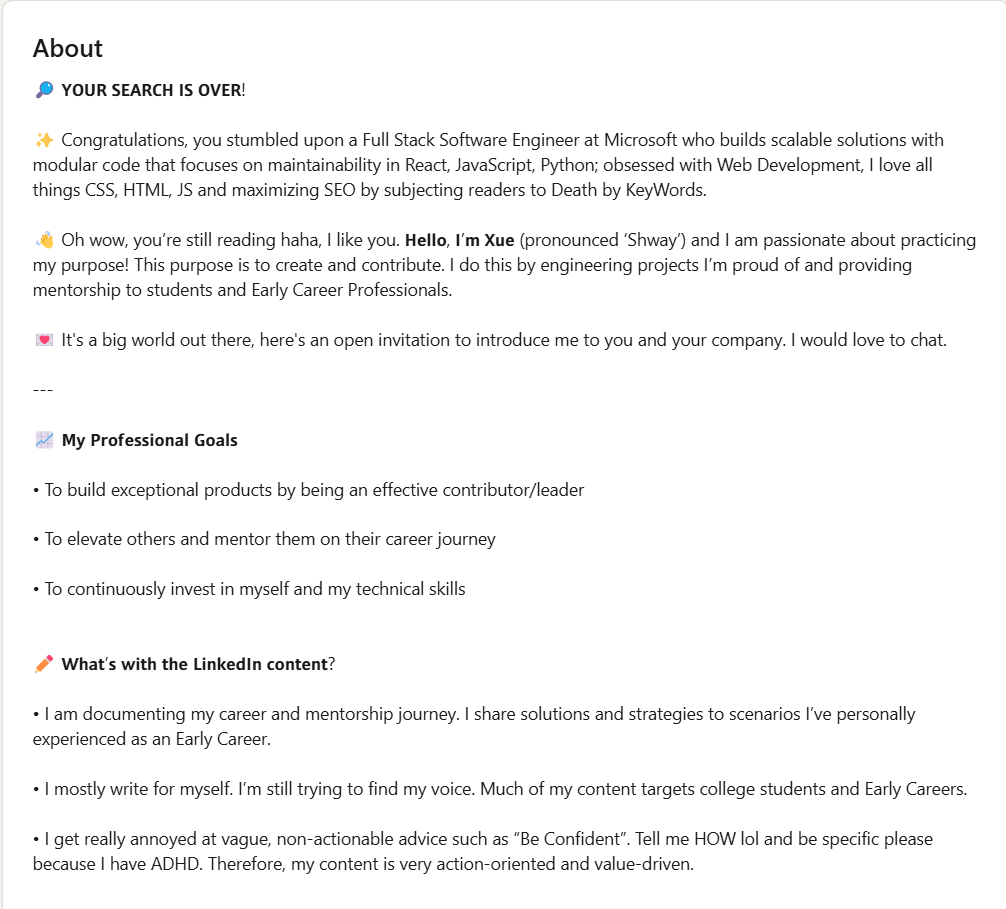
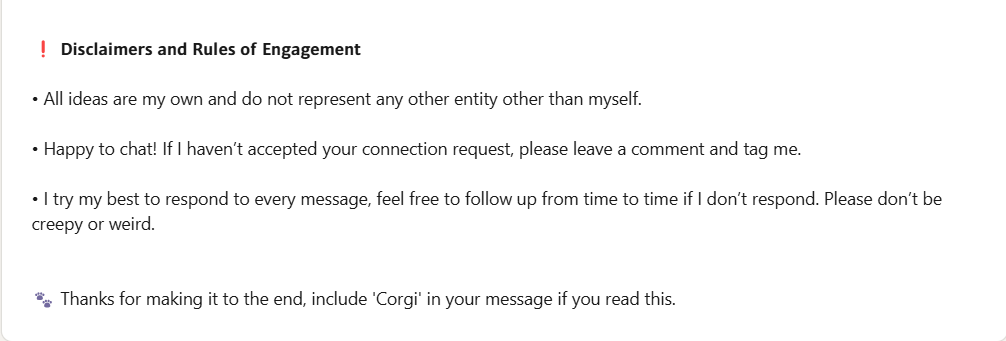
What’s good about this summary?
It’s written in simple language, has light humor and lots of white space. She has listed out her goals making it soo easy to read. At the end there’s a nice CTA which subtly encourages people to message her.
For Digital Marketer
Taken from Andrew Culbertson’s LinkedIn profile.
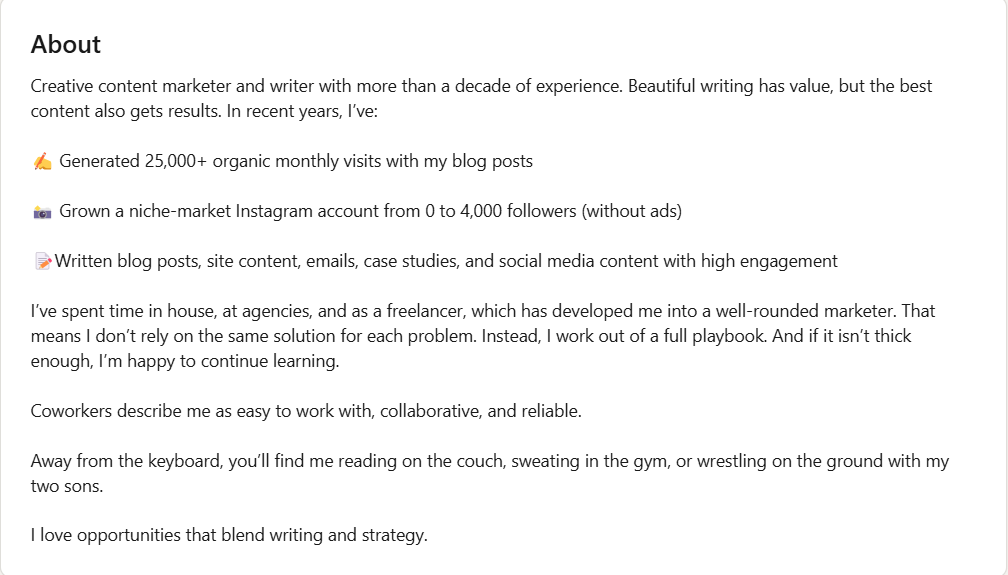
What’s good about this summary?
It’s not too lengthy. Has mentioned achievements in a list form and mentioned soft skills along with hobbies in the summary.
For Content writer
Taken from Lucy Jones’ LinkedIn profile.
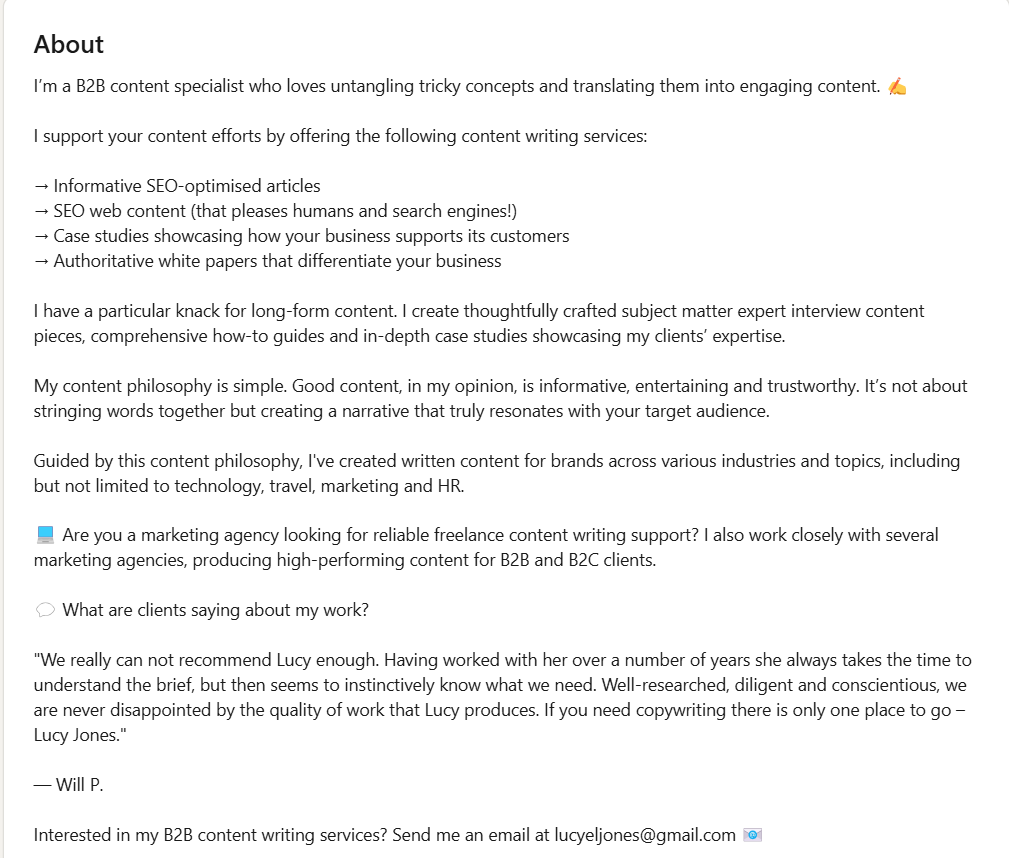
What’s good about this summary?
Simple language, text broken up in easy-to-read short paragraphs. A proper CTA at the end and there’s also a testimonial added in the summary which we loved! If you don’t have a testimonial, you can add recommendations from past colleagues.
For UI/UX designer
Taken from Niharika Dalal’s LinkedIn profile
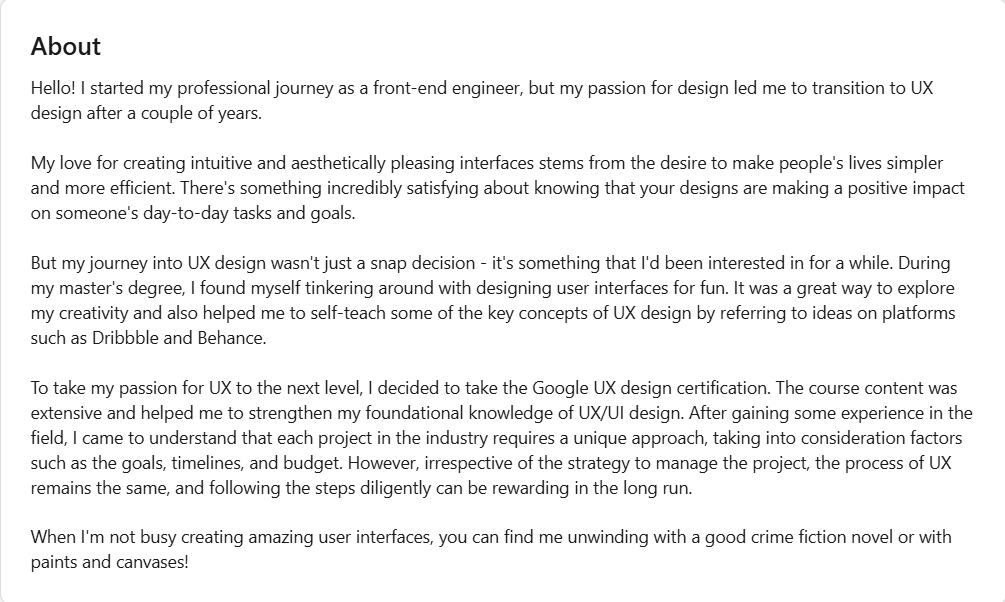
What’s good about this summary?
Clearly mentioned her journey of how she found her passion for design from a different profession. It’s written in a casual and conversational tone. Besides, she also mentioned what she does other than work.
For Financial Accountant/ Analyst
Taken from Girish Dayani’s LinkedIn profile.
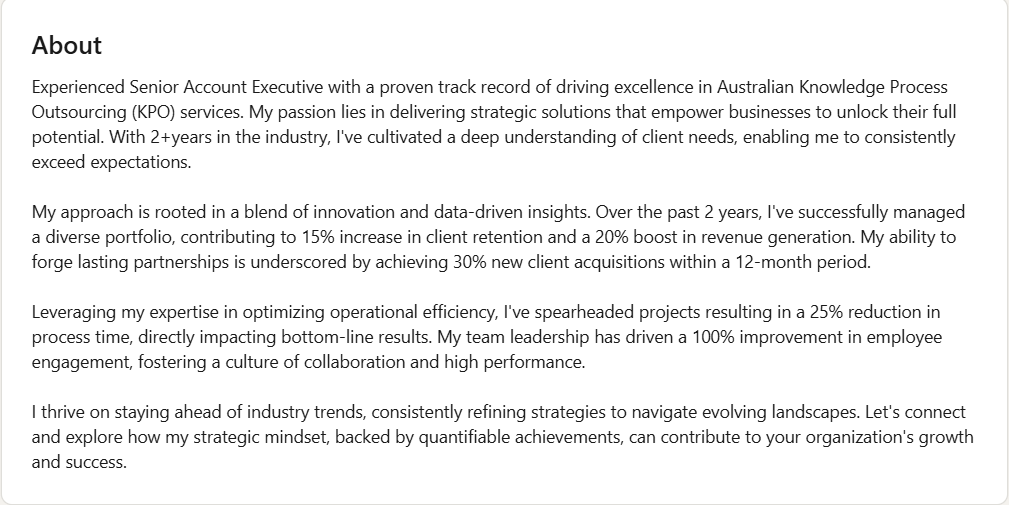
What’s good about this summary?
This summary has a professional tone and mentions all the important information like his achievements, passions, job responsibilities as well as a CTA in the end.
For Graphic Designer
Taken from Arjunan Krishnan’s LinkedIn profile.

What’s good about this summary?
Skills are listed out neatly which will help with better searchability. Not ideal but as a beginner this format works. Here the main focus is on the skills.
For Product Manager
Taken from Aishwarya Jaiswal’s LinkedIn profile.

What’s good about this summary?
Also short and sweet summary. Mentions skills, past experience and soft skills. Plus there’s a CTA at the end.
So, that’s a wrap. This post covers everything you need to know about LinkedIn summaries. And for more questions, check out the faqs below.
FAQs
- How long should a LinkedIn summary be?
Ideally 300 to 500 words is good enough for a LinkedIn profile summary.
- What is the most important element in your LinkedIn summary?
Including lists and bullet points for skills and achievements is the most important element in your summary. Along with mentioning your soft skills.
- What is a good professional LinkedIn summary?
A good professional LinkedIn profile summary contains a brief description of your skills, career journey journeys, achievements and a little about your hobbies, along with a CTA at the end.
Need help in writing the perfect LinkedIn Summary? Create your free account now at https://app.trikl.ai/
